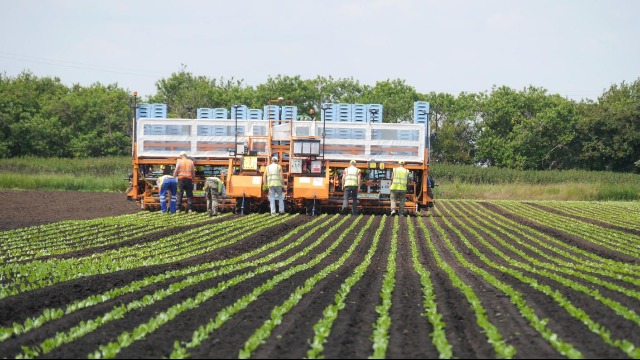At Earlham Institute (EI), artificial intelligence based techniques such as machine learning are moving from being merely an exciting premise to having real-life applications, where it’s needed most: improving efficiency and precision on the farm.
read more – copyright by www.technologynetworks.com
 Researchers in the Zhou Group at EI, in cooperation with Ely-based G’s Growers, have developed a machine learning platform, AirSurf-Lettuce, which works with computer vision and ultra-scale images taken from the air to help categorise lettuce crops in fields.
Researchers in the Zhou Group at EI, in cooperation with Ely-based G’s Growers, have developed a machine learning platform, AirSurf-Lettuce, which works with computer vision and ultra-scale images taken from the air to help categorise lettuce crops in fields.
The advanced software includes measuring quantity, size and pinpointing location to help farmers harvest with precision and getting the crop to market in the most efficient possible way. Importantly, this technology can be applied to other crops, widening the scope for positive impact across the food chain.
Lettuce is big business, especially in East Anglia, with 122,000 tonnes produced in the UK each year. Up to 30% of yield can be lost due to inefficiencies in the growing process as well as harvest strategies, which, if made up, could provide a significant economic boost.
It’s very important that farmers and growers understand precisely when crops will become harvest-ready, so that they can set in motion the planning of logistics, trading and marketing their produce further along the chain.
Traditionally, however, measuring crops in fields has been very time-consuming and labour intensive, as well as prone to error; therefore novel AI solutions based on aerial images can provide a much more robust and effective method.
Another barrier to efficiency is the fact that inclement weather conditions, which have been increasing in recent years, can throw off harvesting times quite significantly, as crops take different lengths of time to mature.
The AirSurf technology – developed by members of the Zhou Group, including first authors of the paper on the project, Alan Bauer and Aaron Bostrom – uses ‘deep learning’ (a deep structured machine learning technique) combined with sophisticated, ultra-wide-scale imaging analysis to measure iceberg lettuce in a high-throughput mode. This is able to identify the precise quantity and location of lettuce plants, with the additional advantage of recognising crop quality, i.e. small, medium or large lettuce heads.
Thank you for reading this post, don't forget to subscribe to our AI NAVIGATOR!
Combining this system with GPS allows farmers to precisely track size distribution of lettuce in fields, which can only help in increasing the precision and effectiveness of farming practice, including harvest time.
First author, Alan Bauer at EI, said: ” This cross-disciplinary collaboration integrates computer vision and machine learning with the lettuce growing business to demonstrate how we can improve crop yields using machine learning.”
Group Leader at EI, Dr Ji Zhou, said: “My lab is keen to seek every possible approach to translate our public funded research in algorithm design, machine learning, computer vision, and crop phenomics to techniques and tools that can be used by academic and industrial partners to address challenging problems in crop research and crop production.[…]
read more – copyright by www.technologynetworks.com


At Earlham Institute (EI), artificial intelligence based techniques such as machine learning are moving from being merely an exciting premise to having real-life applications, where it’s needed most: improving efficiency and precision on the farm.
read more – copyright by www.technologynetworks.com
The advanced software includes measuring quantity, size and pinpointing location to help farmers harvest with precision and getting the crop to market in the most efficient possible way. Importantly, this technology can be applied to other crops, widening the scope for positive impact across the food chain.
Lettuce is big business, especially in East Anglia, with 122,000 tonnes produced in the UK each year. Up to 30% of yield can be lost due to inefficiencies in the growing process as well as harvest strategies, which, if made up, could provide a significant economic boost.
It’s very important that farmers and growers understand precisely when crops will become harvest-ready, so that they can set in motion the planning of logistics, trading and marketing their produce further along the chain.
Traditionally, however, measuring crops in fields has been very time-consuming and labour intensive, as well as prone to error; therefore novel AI solutions based on aerial images can provide a much more robust and effective method.
Another barrier to efficiency is the fact that inclement weather conditions, which have been increasing in recent years, can throw off harvesting times quite significantly, as crops take different lengths of time to mature.
The AirSurf technology – developed by members of the Zhou Group, including first authors of the paper on the project, Alan Bauer and Aaron Bostrom – uses ‘deep learning’ (a deep structured machine learning technique) combined with sophisticated, ultra-wide-scale imaging analysis to measure iceberg lettuce in a high-throughput mode. This is able to identify the precise quantity and location of lettuce plants, with the additional advantage of recognising crop quality, i.e. small, medium or large lettuce heads.
Thank you for reading this post, don't forget to subscribe to our AI NAVIGATOR!
Combining this system with GPS allows farmers to precisely track size distribution of lettuce in fields, which can only help in increasing the precision and effectiveness of farming practice, including harvest time.
First author, Alan Bauer at EI, said: ” This cross-disciplinary collaboration integrates computer vision and machine learning with the lettuce growing business to demonstrate how we can improve crop yields using machine learning.”
Group Leader at EI, Dr Ji Zhou, said: “My lab is keen to seek every possible approach to translate our public funded research in algorithm design, machine learning, computer vision, and crop phenomics to techniques and tools that can be used by academic and industrial partners to address challenging problems in crop research and crop production.[…]
read more – copyright by www.technologynetworks.com
Share this: